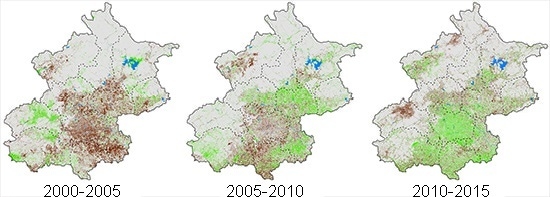Human Activity Influences on Vegetation Cover Changes in Beijing, China, from 2000 to 2015
Abstract
:1. Introduction
2. Materials and Methods
2.1. Study Area
2.2. Data Sources and Pre-Processing
2.3. Methodology
2.3.1. Dimidiate Pixel Model
2.3.2. Piecewise Linear Regression
2.3.3. Bivariate and Partial Correlation Analysis
2.3.4. Factor Analysis
2.3.5. FVC Growth Rate
3. Results
3.1. FVC Estimation Results
3.1.1. Spatial Distribution of FVC
3.1.2. Accuracy Validation
3.2. Spatial-Temporal Variation of FVC during 2000–2015
3.3. Correlations between Climatic Factors and FVC
3.4. Correlations between Human Activities and FVC
3.4.1. Beijing-Tianjin Sandstorm Source Control Project
3.4.2. Socioeconomic Factors
4. Discussion
4.1. Possible Influential Factors for Vegetation Change Trends
4.2. Spatial Heterogeneity of Human Activity Influences
4.3. Limitations and Future Work
5. Conclusions
- (1)
- On an overall basis, from 2000 to 2005, 2005 to 2010, and 2010 to 2015, Beijing experienced both restoration (6.33%, 10.08%, and 12.81%, respectively) and degradation (13.62%, 9.35%, and 9.49%, respectively), the vegetation conditions were better in general, only partially deteriorating.
- (2)
- Human activity factors have significant relationships with vegetation cover changes, and they are a very significant factor in impacting and explaining vegetation changes. The socioeconomic factors, especially the population, were the dominant factors influencing the vegetation condition.
- (3)
- Human activity influences on vegetation coverage were highly spatially heterogeneous, based on the unique context of different areas, which needed to be evaluated comprehensively: in the BTSSCP area, the economic development and ecological restoration project improved the local ecosystem, based on a stable increase in population; in the non-BTSSCP area, the extensive growth and fluctuation of the population, urban expansion, and economic development, caused negative effects on vegetation restoration.
Acknowledgments
Author Contributions
Conflicts of Interest
References
- United Nations. The Millennium Ecosystem Assessment; United Nations: New York, NY, USA, 2005. [Google Scholar]
- Ouyang, Z.; Zheng, H.; Xiao, Y.; Polasky, S.; Liu, J.; Xu, W.; Wang, Q.; Zhang, L.; Xiao, Y.; Rao, E.; et al. Improvements in ecosystem services from investments in natural capital. Science 2016, 352, 1455–1459. [Google Scholar] [CrossRef] [PubMed]
- Tong, S.; Zhang, J.; Ha, S.; Lai, Q.; Ma, Q. Dynamics of fractional vegetation coverage and its relationship with climate and human activities in Inner Mongolia, China. Remote Sens. 2016, 8, 776. [Google Scholar] [CrossRef]
- Dubovyk, O.; Landmann, T.; Erasmus, B.F.N.; Tewes, A.; Schellberg, J. Monitoring vegetation dynamics with medium resolution MODIS-EVI time series at sub-regional scale in Southern Africa. Int. J. Appl. Earth Obs. Geoinf. 2015, 38, 175–183. [Google Scholar] [CrossRef]
- Jiapaer, G.; Liang, S.; Yi, Q.; Liu, J. Vegetation dynamics and responses to recent climate change in Xinjiang using leaf area index as an indicator. Ecol. Indic. 2015, 58, 64–76. [Google Scholar]
- Kutiel, P.; Cohen, O.; Shoshany, M.; Shub, M. Vegetation establishment on the Southern Israeli Coastal sand dunes between the years 1965 and 1999. Landsc. Urban Plan. 2004, 67, 141–156. [Google Scholar] [CrossRef]
- Liu, T.; Yang, X. Mapping vegetation in an urban area with stratified classification and multiple endmember spectral mixture analysis. Remote Sens. Environ. 2013, 133, 251–264. [Google Scholar] [CrossRef]
- Tooke, T.R.; Coops, N.C.; Goodwin, N.R.; Voogt, J.A. Extracting urban vegetation characteristics using spectral mixture analysis and decision tree classifications. Remote Sens. Environ. 2009, 113, 398–407. [Google Scholar] [CrossRef]
- Matteucci, S.D.; Totino, M.; Arístide, P. Ecological and social consequences of the forest transition theory as applied to the Argentinean Great Chaco. Land Use Policy 2016, 51, 8–17. [Google Scholar] [CrossRef]
- Liu, Y.; Feng, Y.; Zhao, Z.; Zhang, Q.; Su, S. Socioeconomic drivers of forest loss and fragmentation: A comparison between different land use planning schemes and policy implications. Land Use Policy 2016, 54, 58–68. [Google Scholar] [CrossRef]
- Hansen, M.C.; Potapov, P.V.; Moore, R.; Hancher, M.; Turubanova, S.A.; Tyukavina, A.; Thau, D.; Stehman, S.V.; Goetz, S.J.; Loveland, T.R.; et al. High-resolution global maps of 21st-century forest cover change. Science 2013, 342, 850–853. [Google Scholar] [CrossRef] [PubMed]
- Hansen, M.C.; Stehman, S.V.; Potapov, P.V. Quantification of global gross forest cover loss. Proc. Natl. Acad. Sci. USA 2010, 107, 8650–8655. [Google Scholar] [CrossRef] [PubMed]
- Dymond, J.R.; Stephens, P.R.; Newsome, P.F.; Wilde, R.H. Percentage vegetation cover of a degrading rangeland from SPOT. Int. J. Remote Sens. 1992, 13, 1999–2007. [Google Scholar] [CrossRef]
- Gitelson, A.A.; Kaufman, Y.J.; Stark, R.; Rundquist, D. Novel algorithms for remote estimation of vegetation fraction. Remote Sens. Environ. 2002, 80, 76–87. [Google Scholar] [CrossRef]
- Zhang, W.; Fu, S.; Liu, B. Error assessment of visual estimation plant coverage. J. Beijing Norm. Univ. (Nat. Sci.) 2001, 37, 402–408. (In Chinese) [Google Scholar]
- Johnson, B.; Tateishi, R.; Kobayashi, T. Remote sensing of fractional green vegetation cover using spatially-interpolated endmembers. Remote Sens. 2012, 4, 2619–2634. [Google Scholar] [CrossRef]
- Zhang, X.; Liao, C.; Li, J.; Sun, Q. Fractional vegetation cover estimation in arid and semi-arid environments using HJ-1 satellite hyperspectral data. Int. J. Appl. Earth Obs. Geoinform. 2013, 21, 506–512. [Google Scholar] [CrossRef]
- Cao, Q.; Yu, D.Y.; Georgescu, M.; Han, Z.; Wu, J.G. Impacts of land use and land cover change on regional climate: A case study in the agro-pastoral transitional zone of China. Environ. Res. Lett. 2015, 10, 124025. [Google Scholar] [CrossRef]
- Wu, D.; Wu, H.; Zhao, X.; Zhou, T.; Tang, B.; Zhao, W.; Jia, K. Evaluation of spatiotemporal variations of global fractional vegetation cover based on GIMMS NDVI data from 1982 to 2011. Remote Sens. 2014, 6, 4217–4239. [Google Scholar] [CrossRef]
- Zhang, F.; Tiyip, T.; Ding, J.; Sawut, M.; Johnson, V.C.; Tashpolat, N.; Gui, D. Vegetation fractional coverage change in a typical oasis region in Tarim River watershed based on remote sensing. J. Arid Land 2012, 5, 89–101. [Google Scholar] [CrossRef]
- Tang, J.; Chen, F.; Schwartz, S.S. Assessing spatiotemporal variations of greenness in the Baltimore–Washington Corridor area. Landsc. Urban Plan. 2012, 105, 296–306. [Google Scholar] [CrossRef]
- Huang, K.; Zhang, Y.; Zhu, J.; Liu, Y.; Zu, J.; Zhang, J. The influences of climate change and human activities on vegetation dynamics in the Qinghai-Tibet Plateau. Remote Sens. 2016, 8, 876. [Google Scholar] [CrossRef]
- Sun, J.; Cheng, G.; Li, W.; Sha, Y.; Yang, Y. On the variation of ndvi with the principal climatic elements in the Tibetan Plateau. Remote Sens. 2013, 5, 1894–1911. [Google Scholar] [CrossRef]
- Feng, Q.; Ma, H.; Jiang, X.; Wang, X.; Cao, S. What has caused desertification in China? Sci. Rep. 2015, 5, 15998. [Google Scholar] [CrossRef] [PubMed]
- Lu, Y.; Zhang, L.; Feng, X.; Zeng, Y.; Fu, B.; Yao, X.; Li, J.; Wu, B. Recent ecological transitions in China: Greening, browning, and influential factors. Sci. Rep. 2015, 5, 8732. [Google Scholar] [CrossRef]
- Wang, C.; Gao, Q.; Wang, X.; Yu, M. Spatially differentiated trends in urbanization, agricultural land abandonment and reclamation, and woodland recovery in northern China. Sci. Rep. 2016, 6, 37658. [Google Scholar] [CrossRef]
- Peng, J.; Li, Y.; Tian, L.; Liu, Y.X.; Wang, Y.L. Vegetation dynamics and associated driving forces in Eastern China during 1999–2008. Remote Sens. 2015, 7, 13641–13663. [Google Scholar] [CrossRef]
- Cao, S.; Ma, H.; Yuan, W.; Wang, X. Interaction of ecological and social factors affects vegetation recovery in china. Biol. Conserv. 2014, 180, 270–277. [Google Scholar] [CrossRef]
- Roy, D.P.; Kovalskyy, V.; Zhang, H.K.; Vermote, E.F.; Yan, L.; Kumar, S.S.; Egorov, A. Characterization of Landsat-7 to Landsat-8 reflective wavelength and normalized difference vegetation index continuity. Remote Sens. Environ. 2016, 185, 57–70. [Google Scholar] [CrossRef]
- Zhu, Z.; Fu, Y.; Woodcock, C.E.; Olofsson, P.; Vogelmann, J.E.; Holden, C.; Wang, M.; Dai, S.; Yu, Y. Including land cover change in analysis of greenness trends using all available Landsat 5, 7, and 8 images: A case study from Guangzhou, China (2000–2014). Remote Sens. Environ. 2016, 185, 243–257. [Google Scholar] [CrossRef]
- BMSB. Beijing Statistical Yearbooks. Available online: http://tongji.cnki.net/kns55/Navi/HomePage.aspx?id=N2016010098&name=YOFGE&floor=1 (accessed on 2 February 2017).
- Li, M. The Method of Vegetation Fraction Estimation by Remote Sensing. Master’s Thesis, Institute of Remote Sensing and Digital Earth, Chinese Academy of Sciences, Beijing, China, 2003. [Google Scholar]
- Di, B.; Zeng, H.; Zhang, M.; Ustin, S.L.; Tang, Y.; Wang, Z.; Chen, N.; Zhang, B. Quantifying the spatial distribution of soil mass wasting processes after the 2008 earthquake in Wenchuan, China. Remote Sens. Environ. 2010, 114, 761–771. [Google Scholar] [CrossRef]
- Guo, J.; Zhang, X.; Zhao, L.; Xie, F. Research on spatial pattern changes of vegetation cover in Beijing based on 3S. J. Anhui Agric. Sci. 2009, 17, 8264–8277. (In Chinese) [Google Scholar]
- Jia, K.; Yao, Y.; Wei, X.; Gao, S.; Jiang, B.; Zhao, X. A review on fractional vegetation cover estimation using remote sensing. Adv. Earth Sci. 2013, 7, 774–782. [Google Scholar]
- Liu, G.; Wu, B.; Fan, W.; Li, X.; Fan, N. Extraction of vegetation coverage in desertification regions based on the dimidiate pixel model—A case study in maowusu sandland. Res. Soil Water Conserv. 2007, 2, 268–271. (In Chinese) [Google Scholar]
- Ma, N.; Hu, Y.; Zhuang, D.; Zhang, X. Vegetation coverage distribution and its changes in plan blue banner based on remote sensing data and dimidiate pixel model. Sci. Geogr. Sin. 2012, 32, 251–256. [Google Scholar]
- Rundquist, B.C. The influence of canopy green vegetation fraction on spectral measurements over native tallgrass prairie. Remote Sens. Environ. 2002, 81, 129–135. [Google Scholar] [CrossRef]
- Wittich, K.P.; Hansing, O. Area-averaged vegetative cover fraction estimated from satellite data. Int. J. Biometeorol. 1995, 38, 209–215. [Google Scholar] [CrossRef]
- Hmimina, G.; Dufrêne, E.; Pontailler, J.Y.; Delpierre, N.; Aubinet, M.; Caquet, B.; de Grandcourt, A.; Burban, B.; Flechard, C.; Granier, A.; et al. Evaluation of the potential of MODIS satellite data to predict vegetation phenology in different biomes: An investigation using ground-based NDVI measurements. Remote Sens. Environ. 2013, 132, 145–158. [Google Scholar] [CrossRef]
- Pettorelli, N.; Vik, J.O.; Mysterud, A.; Gaillard, J.M.; Tucker, C.J.; Stenseth, N.C. Using the satellite-derived ndvi to assess ecological responses to environmental change. Trends Ecol. Evol. 2005, 20, 503–510. [Google Scholar] [CrossRef] [PubMed]
- Van Wagtendonk, J.W.; Root, R.R. The use of multi-temporal landsat Normalized Difference Vegetation Index (NDVI) data for mapping fuel models in Yosemite National Park, USA. Int. J. Remote Sens. 2003, 24, 1639–1651. [Google Scholar] [CrossRef]
- Yang, J.; Weisberg, P.J.; Bristow, N.A. Landsat remote sensing approaches for monitoring long-term tree cover dynamics in semi-arid woodlands: Comparison of vegetation indices and spectral mixture analysis. Remote Sens. Environ. 2012, 119, 62–71. [Google Scholar] [CrossRef]
- Yang, X.; Xu, B.; Jin, Y.; Qin, Z.; Ma, H.; Li, J.; Zhao, F.; Chen, S.; Zhu, X. Remote sensing monitoring of grassland vegetation growth in the Beijing–Tianjin sandstorm source project area from 2000 to 2010. Ecol. Indic. 2015, 51, 244–251. [Google Scholar] [CrossRef]
- Carlson, T.N.; Ripley, D.A. On the relation between ndvi, fractional vegetation cover, and leaf area index. Remote Sens. Environ. 1997, 62, 241–252. [Google Scholar] [CrossRef]
- Li, B.; Zhang, L.; Yan, Q.; Xue, Y. Application of piecewise linear regression in the detection of vegetation greenness trends on the Tibetan Plateau. Int. J. Remote Sens. 2014, 35, 1526–1539. [Google Scholar] [CrossRef]
- Liu, H.; Zhang, Y. Research on confirming segment points of time series. Comput. Eng. Appl. 2010, 46, 44–46. (In Chinese) [Google Scholar]
- Zhu, Z.; Piao, S.; Myneni, R.B.; Huang, M.; Zeng, Z.; Canadell, J.G.; Ciais, P.; Sitch, S.; Friedlingstein, P.; Arneth, A.; et al. Greening of the earth and its drivers. Nat. Clim. Chang. 2016, 6, 791–795. [Google Scholar] [CrossRef]
- Jenks, G.F.; Caspall, F.C. Error on choroplethic maps: Definition, measurement, reduction. Ann. Assoc. Am. Geogr. 1971, 61, 217–244. [Google Scholar] [CrossRef]
- Piao, S.; Ciais, P.; Huang, Y.; Shen, Z.; Peng, S.; Li, J.; Zhou, L.; Liu, H.; Ma, Y.; Ding, Y.; et al. The impacts of climate change on water resources and agriculture in China. Nature 2010, 467, 43–51. [Google Scholar] [CrossRef] [PubMed]
- Barriopedro, D.; Gouveia, C.M.; Trigo, R.M.; Wang, L. The 2009/10 drought in China: Possible causes and impacts on vegetation. J. Hydrometeorol. 2012, 13, 1251–1267. [Google Scholar] [CrossRef]
- Piao, S.; Wang, X.; Ciais, P.; Zhu, B.; Wang, T.A.O.; Liu, J.I.E. Changes in satellite-derived vegetation growth trend in temperate and boreal eurasia from 1982 to 2006. Glob. Chang. Biol. 2011, 17, 3228–3239. [Google Scholar] [CrossRef]
- Wu, Z.; Wu, J.; Liu, J.; He, B.; Lei, T.; Wang, Q. Increasing terrestrial vegetation activity of ecological restoration program in the Beijing–Tianjin sand source region of China. Ecol. Eng. 2013, 52, 37–50. [Google Scholar] [CrossRef]
- Lu, D.; Song, K.; Zang, S.; Jia, M.; Du, J.; Ren, C. The effect of urban expansion on urban surface temperature in Shenyang, China: An analysis with landsat imagery. Environ. Model. Assess. 2014, 20, 197–210. [Google Scholar] [CrossRef]
- Feng, L.; Li, J.; Gong, W.; Zhao, X.; Chen, X.; Pang, X. Radiometric cross-calibration of gaofen-1 WFV cameras using Landsat-8 OLI images: A solution for large view angle associated problems. Remote Sens. Environ. 2016, 174, 56–68. [Google Scholar] [CrossRef]
- Tian, H.; Cao, C.; Dai, S.; Zheng, S.; Lu, S. Analysis of vegetation fractional cover in jungar banner based on time-series remote sensing data. J. Geo Inf. Sci. 2014, 16, 126–133. [Google Scholar]
- Han, L.; Zhou, W.; Li, W. Fine particulate (PM2.5) dynamics during rapid urbanization in Beijing, 1973–2013. Sci. Rep. 2016, 6, 23604. [Google Scholar] [CrossRef] [PubMed]
- Sun, X.; Wang, T.; Wu, J.; Ge, J. Change trend of vegetation cover in Beijing metropolitan region before and after the 2008 olympics. Chin. J. Appl. Ecol. 2012, 23, 8. [Google Scholar]
- Wang, C.; Yang, Y.; Zhang, Y. Economic development, rural livelihoods, and ecological restoration: Evidence from China. Ambio 2010, 40, 78–87. [Google Scholar] [CrossRef]
- Salvati, L.; Zitti, M. Natural resource depletion and the economic performance of local districts: Suggestions from a within-country analysis. Int. J. Sustain. Develop. World Ecol. 2008, 15, 518–523. [Google Scholar] [CrossRef]
- Madu, I.A. The impacts of anthropogenic factors on the environment in Nigeria. J. Environ.Manag. 2009, 90, 1422–1426. [Google Scholar] [CrossRef] [PubMed]
- Dewan, A.M.; Yamaguchi, Y. Land use and land cover change in greater Dhaka, Bangladesh: Using remote sensing to promote sustainable urbanization. Appl. Geogr. 2009, 29, 390–401. [Google Scholar] [CrossRef]
- Burgoyne, C.; Kelso, C.; Ahmed, F. Human activity and vegetation change around mkuze game reserve, South Africa. S. Afr. Geogr. J. 2016, 98, 217–234. [Google Scholar] [CrossRef]
- Lu, Y.; Fu, B.; Wei, W.; Yu, X.; Sun, R. Major ecosystems in China: Dynamics and challenges for sustainable management. Environ. Manag. 2011, 48, 13–27. [Google Scholar] [CrossRef] [PubMed]
- Hu, L.; Shao, M. Vegetation coverage index in soil and water loss studies. J. Northwest For. Univ. 2001, 16, 40–43. (In Chinese) [Google Scholar]
- Li, F.; Chen, W.; Zeng, Y.; Zhao, Q.J.; Wu, B.F. Improving estimates of grassland fractional vegetation cover based on a pixel dichotomy model: A case study in Inner Mongolia, China. Remote Sens. 2014, 6, 4705–4722. [Google Scholar] [CrossRef]
- Purevdorj, T.; Tateishi, R.; Ishiyama, T.; Honda, Y. Relationships between percent vegetation cover and vegetation indices. Int. J. Remote Sens. 1998, 19, 3519–3535. [Google Scholar] [CrossRef]
- Schulz, J.J.; Cayuela, L.; Rey-Benayas, J.M.; Schroder, B. Factors influencing vegetation cover change in mediterranean central Chile (1975–2008). Appl. Veg. Sci. 2011, 14, 571–582. [Google Scholar] [CrossRef]
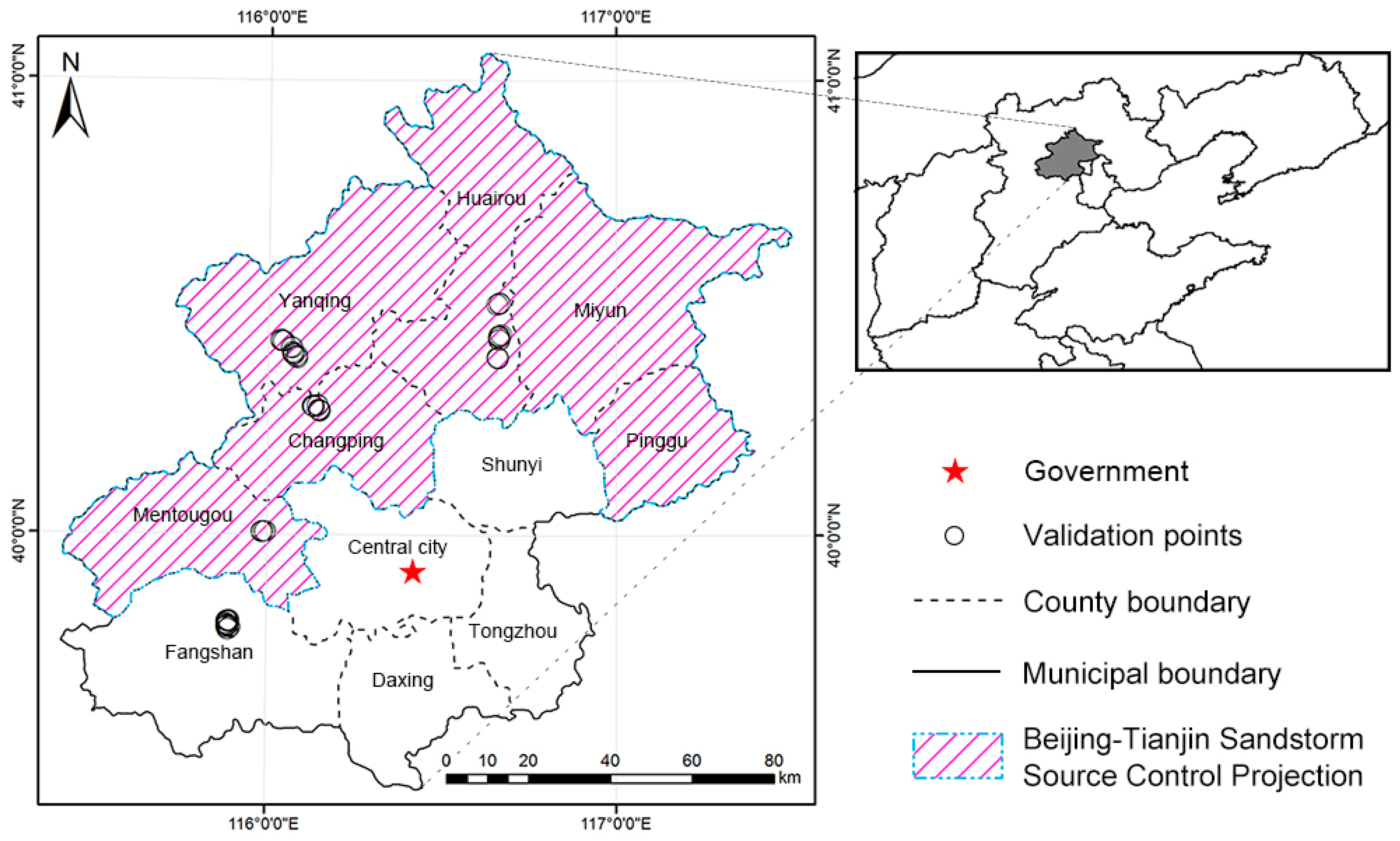
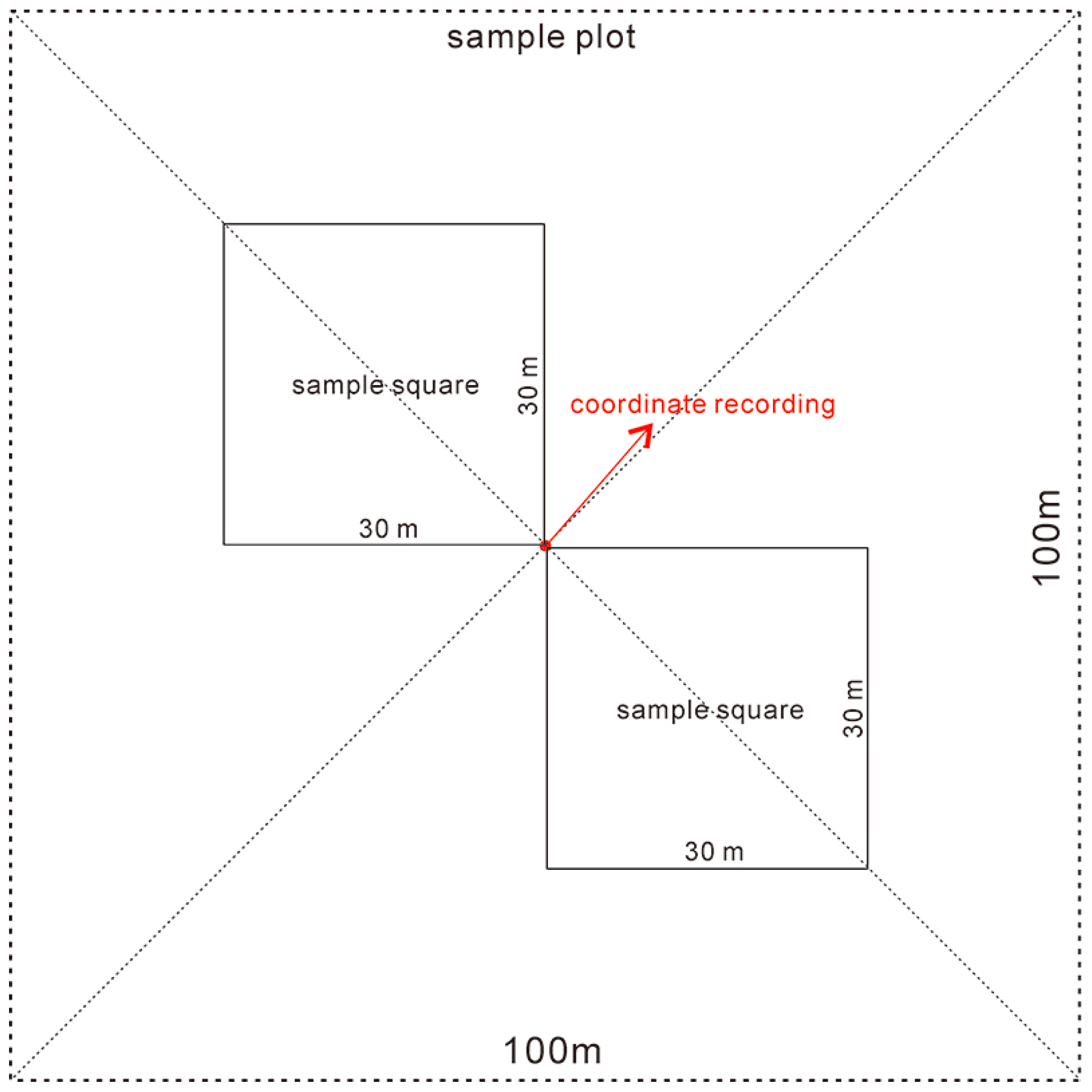
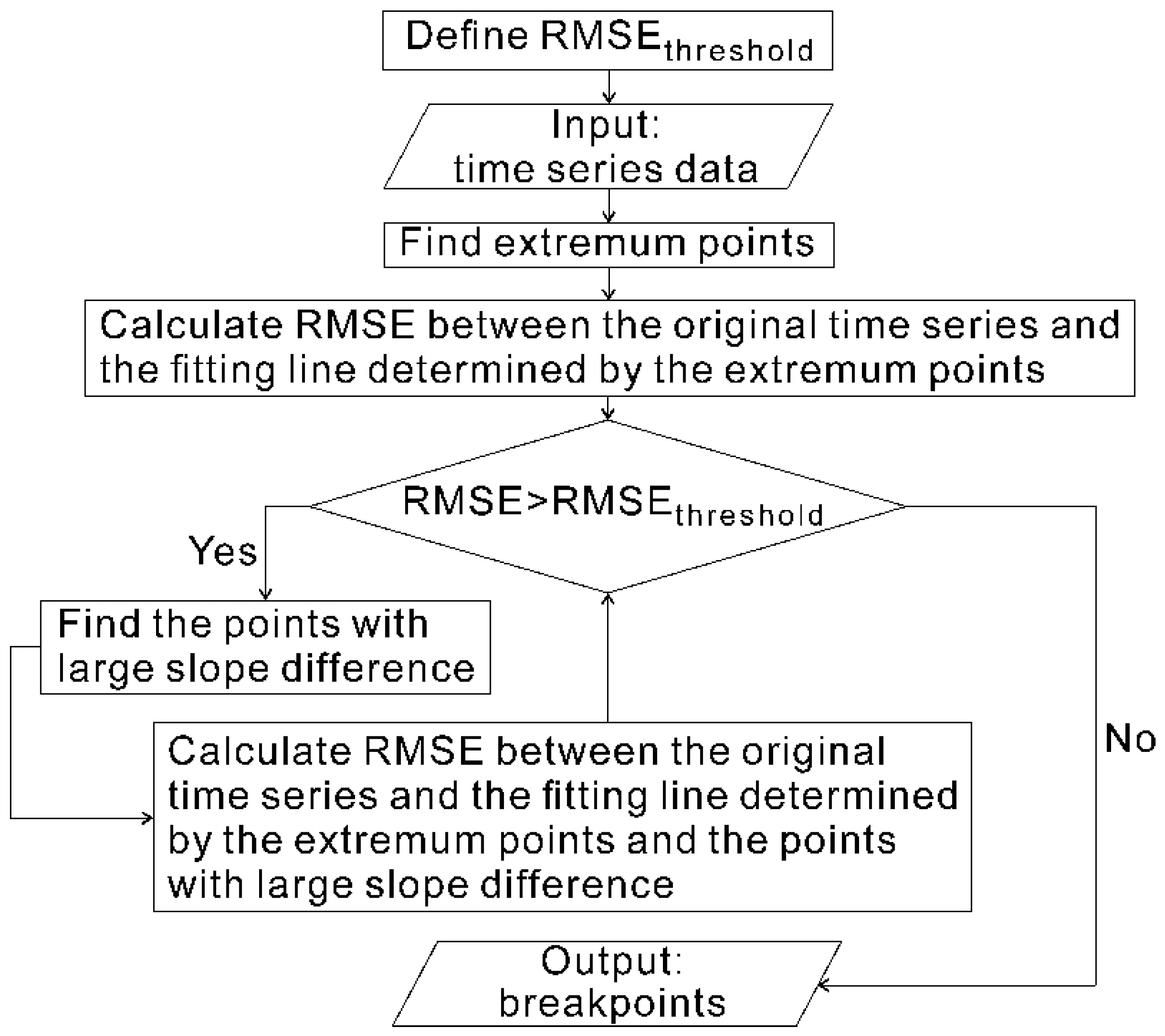


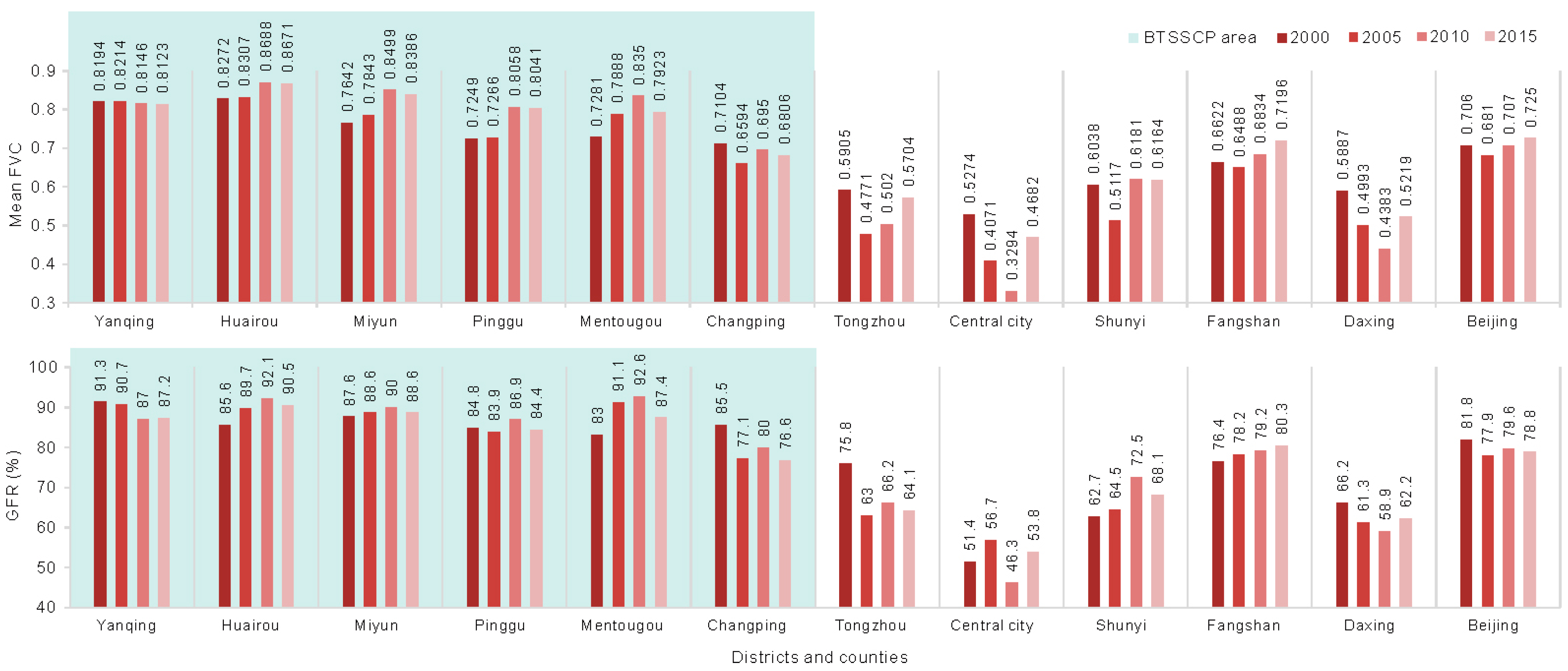
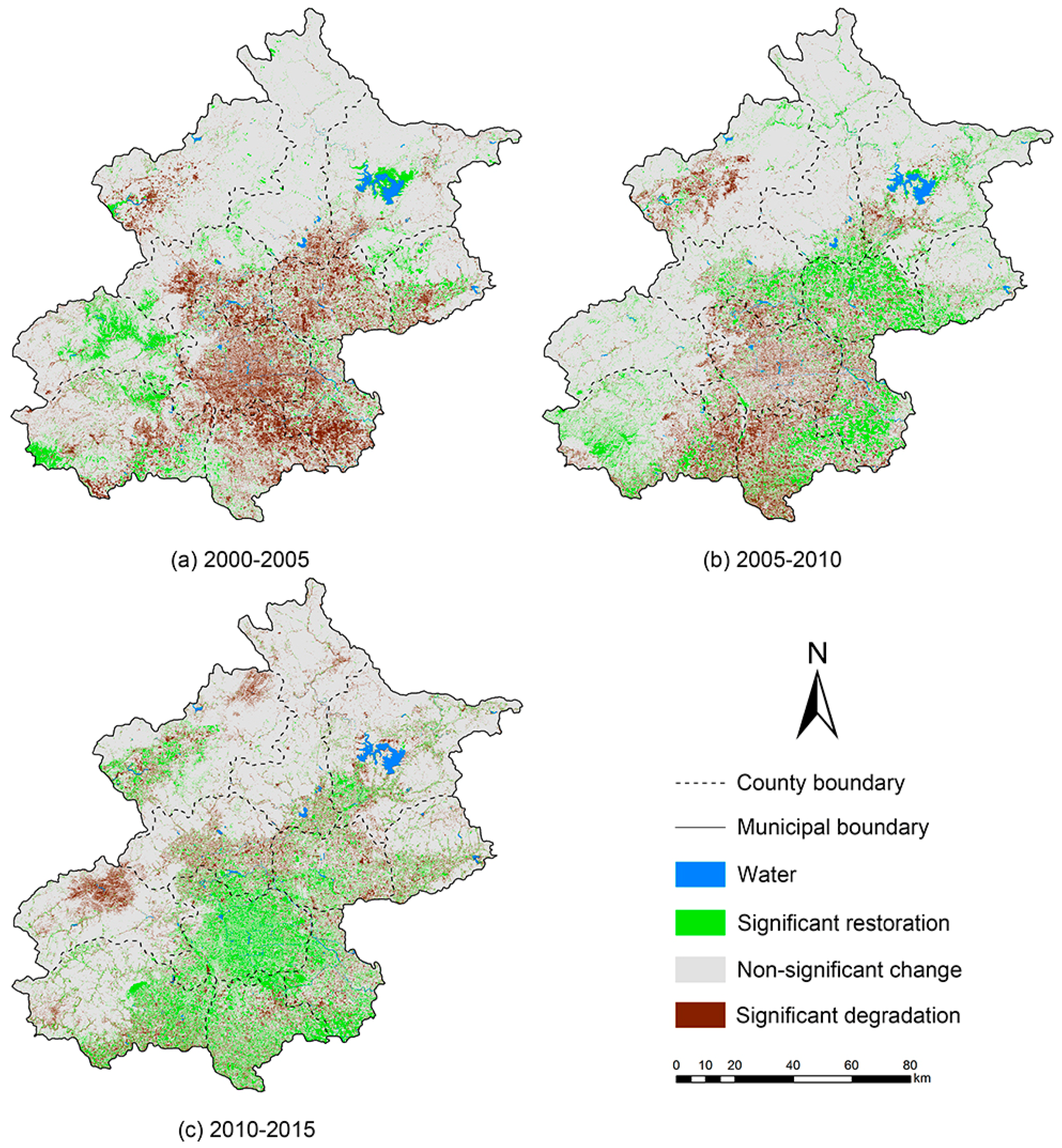
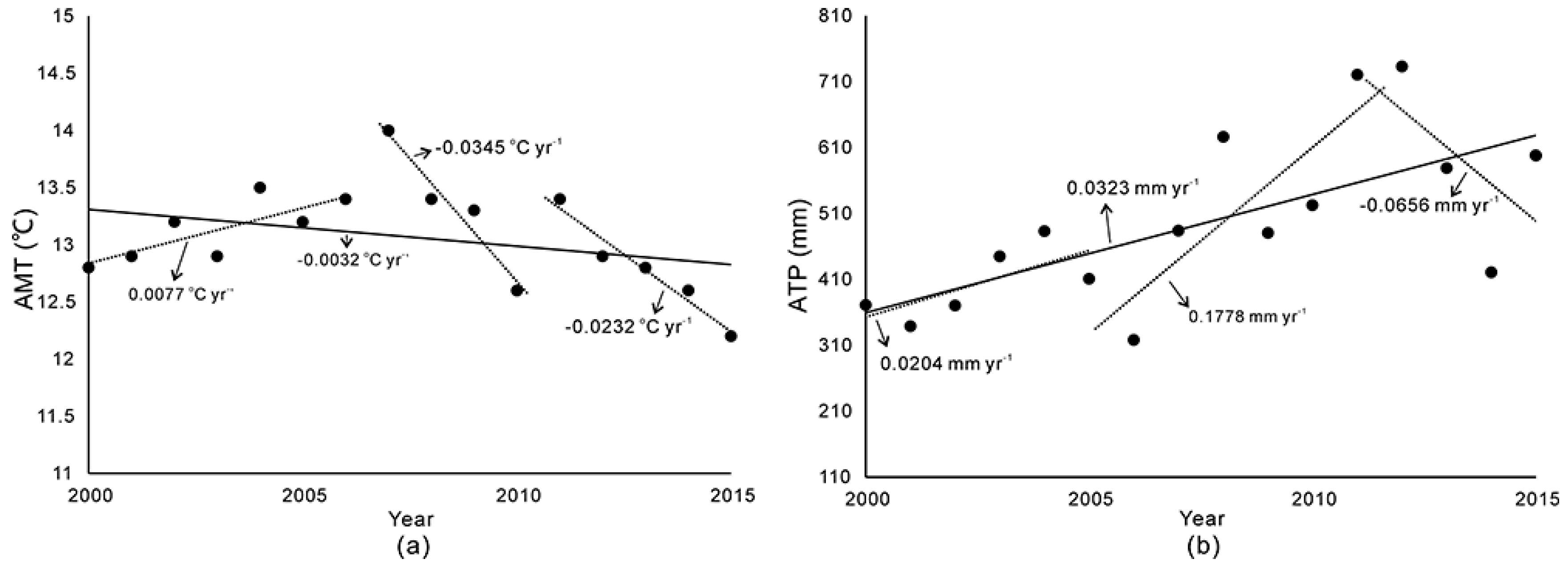
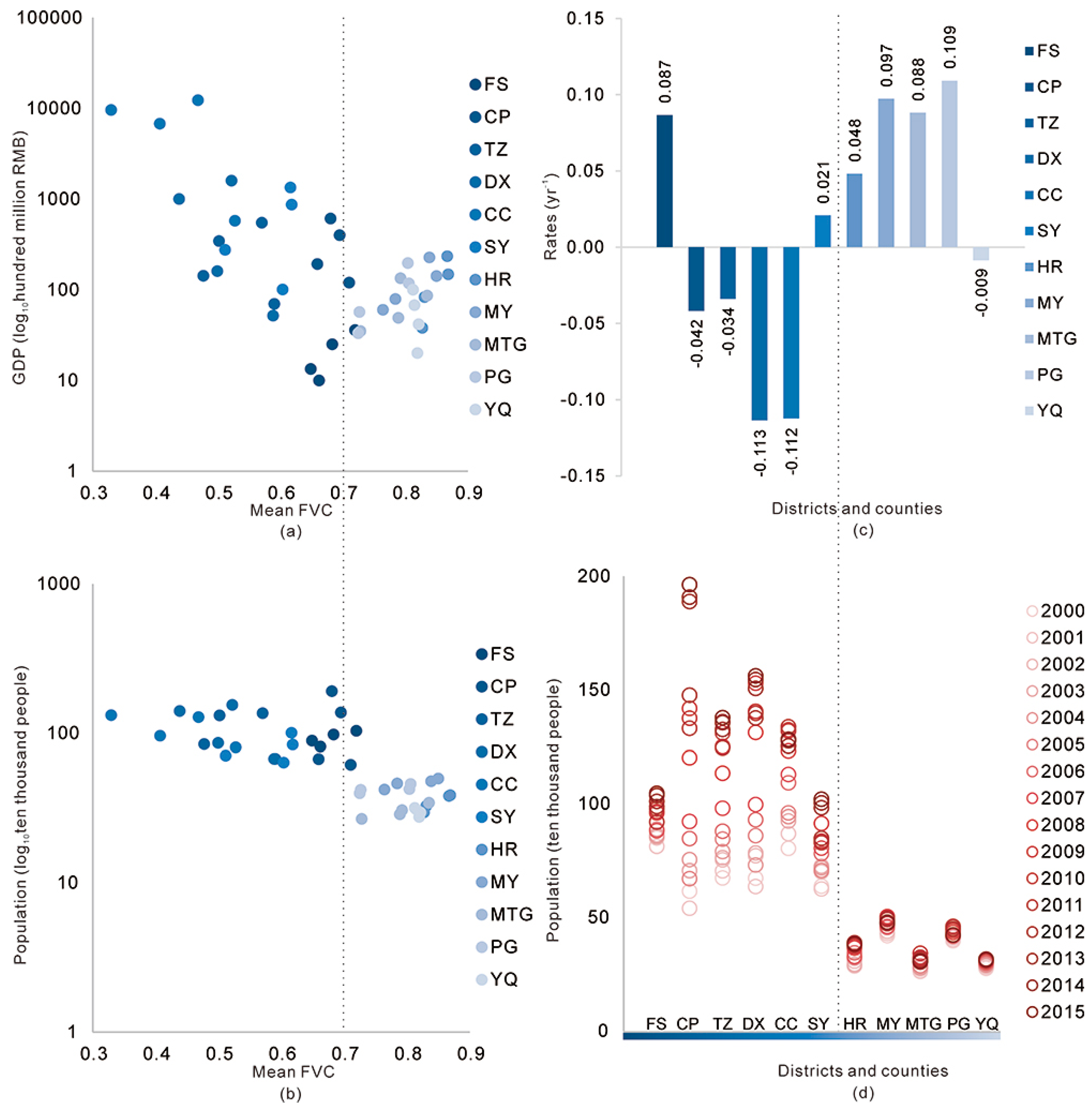
| Levels | Name | FVC Value Ranges |
|---|---|---|
| 1 | Poor | 0–0.3 |
| 2 | Relatively poor | 0.3–0.5 |
| 3 | Moderate | 0.5–0.7 |
| 4 | Relatively good | 0.7–0.8 |
| 5 | Good | 0.8–1.0 |
| Variables | Correlation Coefficients | Significant (p-Value) | Partial Correlation Coefficients | Significant (p-Value) |
|---|---|---|---|---|
| MAMT | −0.69 * | 0.019 | −0.819 ** | 0.004 |
| MAMP | 0.295 | 0.378 | 0.653 * | 0.04 |
| Period | BTSSCP | Non-BTSSCP | ||||||
|---|---|---|---|---|---|---|---|---|
| Restoration (%) | Degradation (%) | Stable (%) | Total Effectiveness | Restoration (%) | Degradation (%) | Stable (%) | Total Effectiveness | |
| 2000–2005 | 5.43 | 1.6 | 92.96 | 96.79 | 9.82 | 8.95 | 81.22 | 82.09 |
| 2005–2010 | 3.07 | 1.11 | 95.81 | 97.77 | 13.34 | 4.74 | 81.92 | 90.52 |
| 2000–2010 | 11.45 | 7.53 | 81.02 | 84.94 | 13.09 | 32.83 | 54.08 | 34.34 |
| 2010–2015 | 1.88 | 5.68 | 92.43 | 88.63 | 11.34 | 6.09 | 82.58 | 87.83 |
| Variables | Correlation Coefficients | Significance (p-Value) | Partial Correlation Coefficients | Significance (p-Value) | Contribution (%) | Cumulative Contribution (%) |
|---|---|---|---|---|---|---|
| Total population | −0.705 *** | 0.000 | −0.684 * | 0.042 | 54.356 | 54.356 |
| GDP | −0.556 *** | 0.000 | −0.125 | 0.749 | 30.677 | 85.032 |
| Engel coefficient of urban | −0.537 ** | 0.005 | −0.186 | 0.631 | 7.579 | 92.612 |
| Engel coefficient of rural | −0.348 | 0.081 | −0.045 | 0.908 | 4.236 | 96.848 |
| Investment in fixed assets | −0.443 ** | 0.01 | 0.143 | 0.713 | 2.112 | 98.960 |
| per capita consumption of urban | 0.166 | 0.448 | 0.018 | 0.963 | 0.767 | 99.727 |
| per capita consumption of urban | 0.158 | 0.484 | 0.134 | 0.731 | 0.273 | 100.0 |
| Change from 2000 to 2015 | Correlation Coefficients | Significance (p-Value) | Partial Correlation Coefficients | Significance (p-Value) |
|---|---|---|---|---|
| population in T-C | −0.175 | 0.415 | 0 | 1 |
| population in H-Y | 0.066 | 0.782 | −0.325 | 0.175 |
| GDP in T-C | −0.617 ** | 0.001 | −0.601 ** | 0.002 |
| GDP in H-Y | 0.553 * | 0.011 | 0.614 ** | 0.005 |
| Categorical Criterion | Districts and Counties | |
|---|---|---|
| BTSSCP/non-BTSSCP | HR, MY, PG, MTG, YQ, CP | TZ, DX, CC, FS, SY |
| Positive/negative vegetation growth | HR, MY, PG, MTG, FS, SY | TZ, DX, CC, YQ, CP |
| Positive/negative GDP influences Stable/non-stable population | HR, MY, PG, MTG, YQ | TZ, DX, CC, FS, SY, CP |
© 2017 by the authors. Licensee MDPI, Basel, Switzerland. This article is an open access article distributed under the terms and conditions of the Creative Commons Attribution (CC BY) license ( http://creativecommons.org/licenses/by/4.0/).
Share and Cite
Jiang, M.; Tian, S.; Zheng, Z.; Zhan, Q.; He, Y. Human Activity Influences on Vegetation Cover Changes in Beijing, China, from 2000 to 2015. Remote Sens. 2017, 9, 271. https://doi.org/10.3390/rs9030271
Jiang M, Tian S, Zheng Z, Zhan Q, He Y. Human Activity Influences on Vegetation Cover Changes in Beijing, China, from 2000 to 2015. Remote Sensing. 2017; 9(3):271. https://doi.org/10.3390/rs9030271
Chicago/Turabian StyleJiang, Meichen, Shufang Tian, Zhaoju Zheng, Qian Zhan, and Yuexin He. 2017. "Human Activity Influences on Vegetation Cover Changes in Beijing, China, from 2000 to 2015" Remote Sensing 9, no. 3: 271. https://doi.org/10.3390/rs9030271





